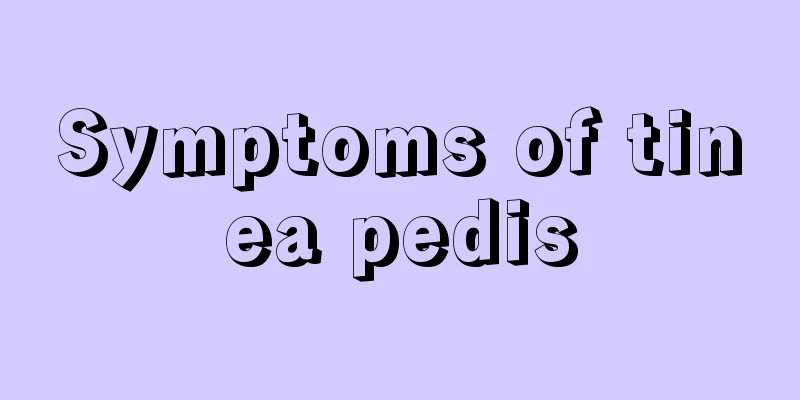Symptoms of tinea pedis

|
Tinea manuum, also known as tinea manuum, is caused by fungal infection. If you have tinea manuum, you will definitely feel itchy hands often, and the skin on your hands will have blisters, papules, desquamation and erythema. It is small at the beginning. If it is not treated in time, or the treatment is unscientific, it will cause great damage to the skin of the hands. Let us understand the symptoms of tinea manuum. Do you know the symptoms of tinea pedis? You may not know much about tinea pedis and rarely see such a disease. Tinea pedis is also called hand tinea. The main cause of this disease is contact transmission and long-term immersion of hands in water. Let us learn about its symptoms below. 1 Causes Tinea manuum is mainly caused by infections such as Trichophyton rubrum (accounting for about 55.6%), tinea barbae (gypsum-like), and Trichophyton (accounting for about 22.7%). The disease is mainly transmitted through contact. The important causes of tinea manuum infection include long-term immersion of hands in water, friction injuries, contact with detergents and solvents, etc. Therefore, the incidence of tinea manuum can be quite high in some industries. Most patients are young and middle-aged women, many of whom have a history of wearing rings. 2 Clinical manifestations 1. Blister-scaly type The onset is usually unilateral. It starts from a certain part of the palm, with needle-sized blisters, thick and shiny walls, and clear fluid inside. The blisters may cluster in groups or be scattered, and may cause itching. After the blisters dry, they desquamate and gradually spread and expand to the surrounding areas, forming ring-shaped or multi-ring-shaped lesions with clear edges. The course of the disease is usually chronic and may last for many years until the entire palm is affected and spreads to the back of the hand and nails, and even the opposite palm. Sometimes blisters can become infected and form pustules. Compared with tinea pedis, tinea manuum is less likely to lead to serious bacterial infection. 2. Keratinosis and thickening It usually develops from the blister-scaly type. Patients often have a history of many years of disease, involving both hands, but can also be unilateral. The skin lesions generally have no obvious blisters or annular desquamation. The palm surface is diffusely red and thickened, the skin lines are deepened, the skin is rough, dry and scaly. Cracks often occur in winter, and sometimes the cracks are very deep and accompanied by bleeding, causing unbearable pain and affecting activities. In addition to dermatophytes, factors that contribute to the thickening of keratinization on the palms are also related to long-term scratching, washing, stimulation by soaps, detergents, various chemicals and solvents, and improper treatment. 3 Diagnosis The lesions start in a certain area of the palm, slowly expand, and eventually involve most or all of the palm, even both sides of the palm. Skin lesions present as erythema, blisters, scaling, and thickened keratinization, and tinea manuum should be considered. A positive mycological examination can confirm the diagnosis. 4 Treatment 1. For the blister-scaly type, you can use miconazole cream, clotrimazole cream, compound benzoic acid ointment, compound resorcinol ointment, etc. The thickened keratosis type can be treated with compound benzoic acid ointment, miconazole cream or soaking in 10% glacial acetic acid. For those with chapped skin, urea fat can be added. Continue to apply the medicine for more than 2 weeks after the skin lesions subside. 2. Because hands are washed frequently, the frequency of topical medication should be increased, especially applying ointment or cream after washing hands. 3. For patients with a long course of disease or poor local treatment effect, oral griseofulvin, ketoconazole or fluconazole, itraconazole, terbinafine and other drugs can be added for treatment. 4. Onychomycosis and tinea manuum are mutually infective and should be treated simultaneously, including tinea in other parts of the body. Tinea pedis is a very common skin disease. The occurrence of this disease has a great impact on us, and different types of it have different symptoms. Everyone should learn more about the symptoms of tinea pedis. If this disease is found, it should be treated with medication in time. In daily life, you must not scratch it with your hands, and avoid soap and organic solvents. |
<<: What are the medicines for treating otitis media
Recommend
What to do if you inhale sulfur dioxide
If you inhale sulfur dioxide into your body, you ...
What are the correct steps for olive oil skin care?
Many times, when people see that someone else has...
Three methods of making enzymes that experts love the most
I believe that many girls who love beauty must be...
Tongue cancer patients need to follow several dietary principles
It is unfortunate to encounter tongue cancer. Not...
What are the benefits of moxibustion on the soles of the feet
Moxibustion is a common treatment method in Tradi...
What are the methods to overcome adolescent madness
Vitiligo affects a wide range of people, regardle...
Dull pain on the left side of the sternum
If you feel a dull pain on the left side of your ...
What are the symptoms of advanced gastric cancer
What are the symptoms of advanced gastric cancer?...
What should I pay attention to if I have Hepatitis B?
For patients with small triple positive, conditio...
Traditional Chinese Medicine Methods for Treating Vocal Cord Paralysis
If vocal cord paralysis occurs, some traditional ...
Early symptoms of skin cancer are similar to those of psoriasis
The early symptoms of skin cancer can occur anywh...
What causes swollen and painful clavicle?
Nowadays, many people feel pain in the clavicle f...
Is the cure rate of advanced lymphoma high?
Is the cure rate of lymphoma high in the late sta...
Can I eat fish after bladder cancer surgery
You can eat fish after bladder cancer surgery. Fi...
Are there parasites in eggs?
Eggs are rich in protein, and the protein content...









